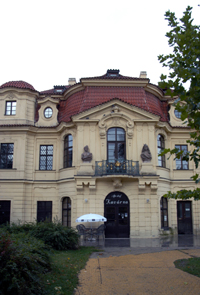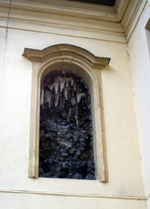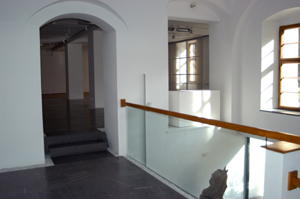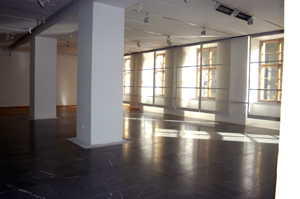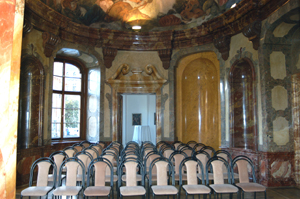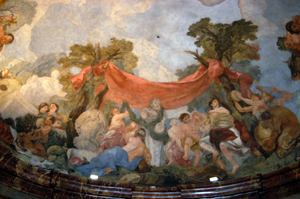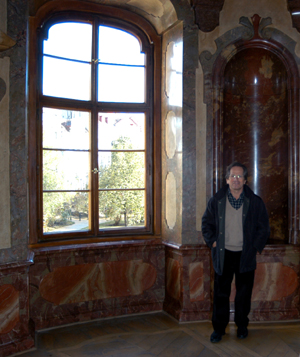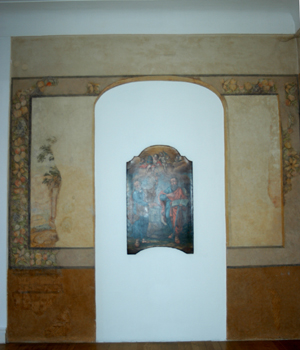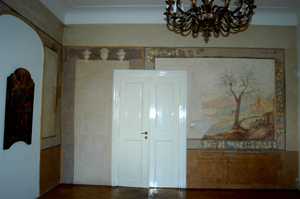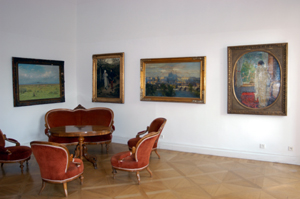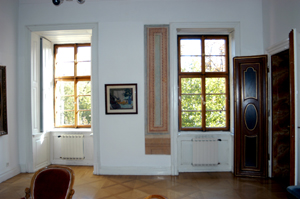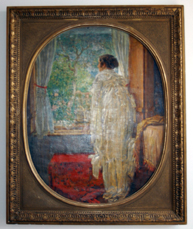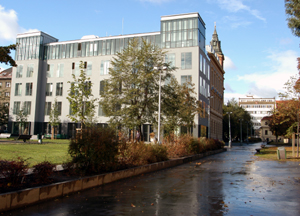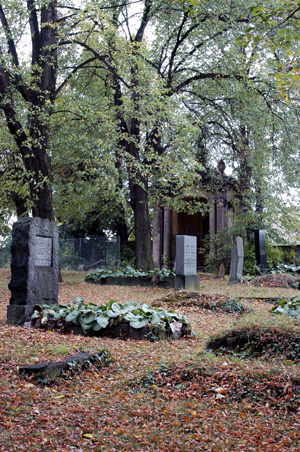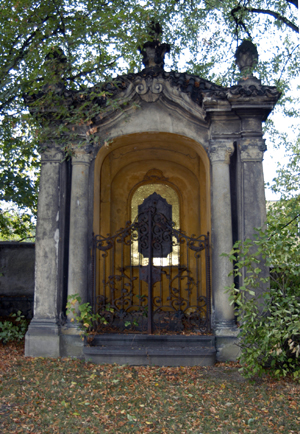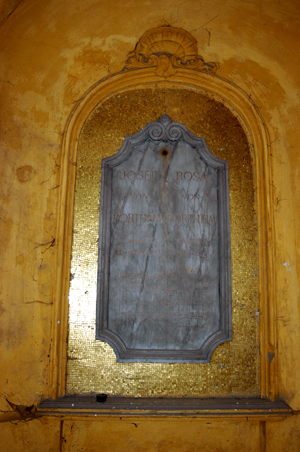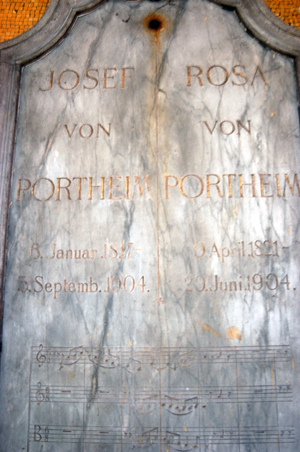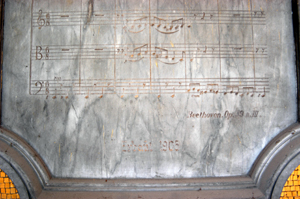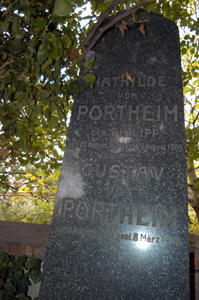|
The Porges von Portheim Palace in Prague
Excerpt from :
CASTLES, PALACES, and CITADELS
in
BOHEMIA, MORAVIA and SILESIA, PRAGUE and surrounds
|
Published by Nakladatelstvi
- Svoboda - Praha 1988
(translation)
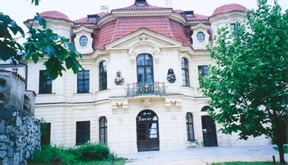
PORTHEIMKA Summer Palace, Prague 5 Smichov.
In 1722, K.I. Dienzenhofer bought a part of the
Smichov plot which had, before the Trussite wars, belonged to the
Carthusian monastries.
After 1620, Michnum z Vacinova took over, by 1728
K.I.Dienzenhofer had built a summer palace for his family (this
is to-day number 68).
It was a simple one-story building with a highly
decorated garden entrance gate where, at the ground floor level,
they built a remarkable salla terrena, as well as an oval marble
hall on the first floor, whose ceiling in 1729 was painted by V.V.
Reinera "Bacchanalia".
The two lower wings were added later.
In 1752, after the death of the architect, because
of family quarrels among the heirs, the castle was sold. In 1758
it was acquired by Count Francis Leopold of Buquoy-Longeval who
not only had the gardens enlarged, extending them all the way to
the Moldau, but also added an Orangerie, the fig House and extensive
glass houses, where many famous parties took place.
(from that time onwards, it was called Bukvojka).
His heir, however, let the building and it was
used as a garden restaurant.
The badly kept residence deteriorated to such an
extent that, when purchased in 1804 by F. Delorme, it became a chicory
processing plant. The plot was then bought in 1828 by Moses and
Juda von Portheim who erected a cardboard factory near the Moldau
and adapted the former summer palace to a family home.Josef von
Portheim later added another story to the side wings.
These were used in the 1870's as a music center,
and in the marble hall, many virtuosi appeared, as well as a resident
quartet whose violinist was none other than Antonin Dvorak.
When the suburb of Smichov built the basilica of
St. Wenceslas, they bought part of the gardens, and in 1884 the
right wing of the palace was pulled down, thus affecting the symmetry
of the building.
Even the original small summer palace was affected
by these regulations (?). but the Portheims managed to save it,
although raising the level of the surrounding streets damaged both
the garden and building.
After the Second World War, the garden was opened
to the public and the summer palace restored.
PLAQUE : The baroque Pavillion in Killian erected
by Ignace Diesenhoffer between 1722 & 1729.
On the 1st floor, the Hall is decorated with ceiling
paintings by Vavlav Vavrince Reiner, former name "Buquoika",
according to the proprietor F. Leopold Buquois, an addition of the
side wings were added in 1758.
Source : Eva Sandrof, member of the von Portheim
family. New Jersey, 2001
|
The story of the villa Portheimka
This baroque villa was
built by Kilian Ignac Dientzenhofer, famous architect of the
Czech baroque, the author of St. Nicholas church on the Old
Time Square ("Staromestske namesti") and the co-
author of the St. Nicholas church on the Small Side Square
("Malostranske namesti").
In 1725, Kilian Ignac
Dientzenhofer started to build a multi-story villa with 4
pavilions and an attic on a piece of land facing the river
Vltava (today's border of Matousova and Stefanikova streets).
The villa was finished with a decorative stucco and the balcony
was completed with two allegoric busts representing Day and
Night. The main oval salon, preserved till this day, was tiled
with artificial marble. The floor was laid with multi-colored
wood and the ceiling adorned by Bacchus on his goat leading
a group of dancing nymphs, satire, flute and drum players.
The author of the fresco was a friend of Dientzenhofer, his
colleague and the godfather of Dientzenhofer's children, Vaclav
Vavrinec Reiner.
In front of the villa,
there was a French park with statues, swimming pools, fountains
and a chestnut orchard. The building and the park were built
on an axis which went through the marble salon. Therefore,
the left and the right side mirrored each other.
For 20 years, Dientzenhofer
received his important guests here, did his work and relaxed
with his family. After his death, his successors fought over
the property and finally decided to sell it in 1753 to Felicitas
Neil from Nellenberg .However, she did not keep it for too
long. Five years later, she sold the property to duke Frantisek
Leopold Buquoy, a lover of art, music and poetry and a known
maecenas (patron). The new owner rearranged the interior,
bought more modern and comfortable furniture, built green
houses with exotic plants and aviary with birds. This improved
park in style of rococo provided opportunities for concerts
and wine making.
In 1768, after the duke's
death, the next owner of the building and the surrounding
gardens became his son Jan Nepomuk. He didn't spend much in
the villa, yet several times invited W.A. Mozart whom he knew
from the Viennese free mason circles. Mozart is thus connected
to Smichov not only through Bertramka but also through "Bukvojka"
as the villa acquired this new name. In order to maintain
the unused building, Jan Nepomuk rented the property to duke
Josef Koch who created guest rooms and turned the house into
an inn. However, it was evident soon that the business was
not a very honest one, (the villa was rather known as a brothel)
and the business had to be closed by authorities.
The next tenant, a Dutchman
Frantisek Delorine, built a chicory roasting plant (a popular
coffee substitute of our predecessors) in the former rococo
park. In 1815, the Buquoy family sold the property to Mojzis
(Moses)(1781-1870) and Juda (1784-1869) Porges.
The Porges brothers
came from a very different background than the previous aristocratic
owner. Although they grew up in the place of today's luxury
hotel Intercontinental, in their times it was an unattractive
corner of the Prague's Jewish quarter. At the so-called "Jansky
Placek" (Jansky square), they opened up a small shop
where one brother with his wife and children printed calico
fabrics. In those times, the Jews did not have much choice
in ways of supporting themselves. They were not allowed to
practice a trade, and they were not accepted by guilds. However,
the Austrian government did not consider (and probably fortunately)
calico printing to be a trade requiring a trading license.
For this reason most of calico factories by the river Vltava
(water was necessary for production) were owned by Jewish
families.
In 15 years, Mojzis
and Juda (who later accepted name Leopold) from the despised
Jewish ghetto became the owners of one of the biggest calico
plants in the entire Austria. In times of boom, they employed
around 1.000 workers. Also, the brothers rebuilt the decayed
house into a representative family mansion. In the garden
facing the river, they built a print factory , which was the
first to be powered by steam.
During this time, Austria
was ruled by Emperor Ferdinand V, the last crowned Czech king.
They called him "The Kind", a euphemistic expression
describing him as agreeable (kind) but slow nature (with plain
soul). The emperor was fond of technical discoveries, especially
those that seemed to "move by themselves". In June
1841, Ferdinand visited Prague with his wife and also came
to see the Porges' factory .He saw the steam machine for the
first time and greatly admired it. He decided to express his
gratitude.
In a short time, he
sent a word from the Viennese court asking whether the factory
owners would prefer to accept an emperor's medal or to be
knighted. Mojzis Porges, remembering his poor and despised
childhood in ghetto, replied that he would prefer a declaration
by which all Jews in the empire would become equal with other
residents. According to available information, even count
Chotek, the highest "purkrabi" (note: perhaps purkrabi
could have been one of the highest positions in the Prague's
castle or burg ???) interceded for the fulfillment of this
request. Such a radical act, however, was unthinkable at the
court.
On June 5, 1841, instead
of equality with other residents, the Porges brothers accepted
the aristocratic status with the name von Portheim. The name
was taken after the Portuguese town Oporta where the family
originated.
In 1844, there were
many workers' riots. The modern printing machine by Perrot
replaced 20 working people. In addition to this, Europe experienced
a crisis in textiles sales and many factories started layoffs.
Workers protested against purchase of machines by destroying
factories' machinery and often did not spare the owners. And
since most calico owners were Jewish, the worker's riots became
pogroms against the Jews, including forced "christenings".
The police had to restore order.
The Villa now known
as Portheimka and the year 1844 were associated with anew
story . The teacher of the Porges' children was a poet, author,
later revolutionist and a confidant of the Austrian police
- Karel Sabina. He fell in love with the chamber-maid of the
lady of the house. Under the pretense of a funeral, he borrowed
the carriage with the aristocratic symbol of Portheims and
took his girlfriend for a ride. When Madam Porges was getting
ready to the theatre, she realized that she had no transportation.
Of course, Sabina's lie was discovered and consequently, he
was fired. He asked for forgiveness, was granted pardon and
was eventually re-instated. However, after other incidents
he was removed. Nevertheless, the love lasted, two children
resulted from it, and ...there was a wedding.
Both brothers had other
interests than just their business. They loved music (Leopold
himself played the violin), and they supported many artists.
Moreover, Mojzis, at the occasion of the golden anniversary
of his marriage on April 16, 1865, started a foundation with
the amount of 1,800 "zlatych" (golden coins). He
made sure that his grandchildren would continue to support
an orphanage which he started. Every year, on the date of
his wedding anniversary, 172 children were to be fed and 3
children completely dressed. In Smichov, he started another
foundation that supplied free textbooks. He also remembered
the adult population. From the profit of three bonds, 12 struggling
citizens of Smichov were paid support.
After the brothers'
death, the building and the gardens lost their original shape.
The south wing of the house became the victim of the neo-gothic
construction of St. Vaclav's Church. The City market and "Narodni
dum" (National house) were added to the garden.
However, the heir Josef
von Portheim (note : brother of the great grand mother of
Irma Sandage, who provided the present article) continued
the music-Ioving activities of his father and uncle. He founded
the Chamber Music Company, and performed publicly himself
(playing the violoncello); he also sponsored many Prague's
concerts. Together, with the owner of Villa Bertramka, he
founded the Mozart Monument and placed Mozart's bust in the
garden. Every other Sunday, the garden hosted a chamber music
concert with Antonin Dvorak as a member of the house band.
Dvorak commemorated one of his compositions to the host. Often,
social gatherings and lectures attended by well known guests
from Prague and abroad were held there. The marble salon was
renovated, completed with a crystal chandelier and rococo
furniture. There was a dinning room salon, private rooms,
studies, library and a winter garden in the villa.
The Portheims also supported
the creative arts -the walls were adorned with paintings by
classical and contemporary artists. Josef's daughters, Augusta
and Jindriska (pronounce Yindzhishka), were good artists themselves.
Another well-known member of the family was a member of the
parliament and a member of the city council in Smichov, Gustav
von Portheim. He founded the so-called Smichov's Casino (which
listed many important persons among its members) in order
to enhance the social status of the suburb. Popular and scientific
lectures were given here, and the building housed a public
library.
The villa remained Portheim's
property until the Second World War. When the Nazis came to
power, transports to concentration camps had started. Jewish
families had three options -to leave the country, accept their
fate and hope to survive the transports, or commit suicide.
The last owner of the Portheim villa, Karel, chose suicide.
The art collection was confiscated and after the liberation
it became the property of the National gallery and the Museum
of Applied Arts. The villa housed various institutions, including
a "propaganda center" and Gallery D. The furnishing
and the building were falling into decay, even though the
building was a few times poorly reconstructed without much
artistry. Finally, the house had fallen into the greyness
of the suburb of Smichov which was written off by the communists.
Source :
Irma Sandage,
née von der Porten ( Joseph Porges was the brother of
her great grandmother) 2002. |
| After
her visit to Prague in June 2001, Eva Sandrof wrote :
" ... I also found the palace. It is
next to the church mentioned, at 9 Matousova Street in Smichov
(Prague 5), which is the address you gave me… the café
is in the building, but wasn’t open on Saturday when
I was there.
However, I was in luck in that we met the woman who is director
of the building, which is owned by the city and being developed
as an arts center.
She doesn’t speak any English (or
German) but a young woman who spoke fluent English was with
her and did the translating.
After I assured them that I did
not want to stake a claim to the house, she let us in.
Upstairs,
the magnificent Reiner Room, (named after the painter who
painted the still intact ceiling) is still intact, brown marble
and all.
Quite impressive!
The rest of the house seems to be in good
condition, but has been and is being divided for artists’
galleries and other artistic related functions.
The main quarters
of the art center is two blocks away on the other side of
the garden, in a magnificently restored art deco building.
The properties are the pet project of a wealthy man who would
like to see it all united.
I left them with copies of the
documents I sent you [see above], since they know very
little about the history of the house.
It is called Villa Portheimka.
I also gave them information and the address of the Porges
website.
The name of the director is : Ing. Jana Blahoutova
Nuselska 19, 140 00 Praha 4
Tel/fax 02/692 56 56, 692 31 95, 612 15 410
I took the above from her card, which she gave me.
The young woman, who speaks English, is a professional photographer
and was very excited about the family connection. If you want
to arrange a visit, it might be better to contact her :
Iveta Kopicova
Tel - 0602 707 223 , e-mail – fotoiveta@sendme.cz
Incidentally to get to the palace, take the yellow line subway
to the Andel stop.
Once there, cross the large bus station
to the main street – Nadrazne Street – walk to the
left (the street is soon named Stefankova Street) – Walk
about five minutes, until you see the church on the right
and the yellow building, Villa Portheimka, right after it.
"
|
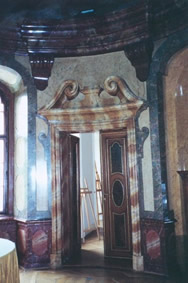
The Reiner room |
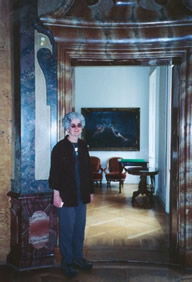
Eva Sandrof visiting the Palace
of her ancestors in Prague (June 2001) |
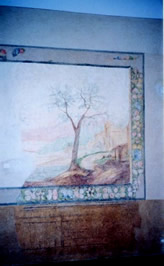
Fresco
|
The webmaster visited
Prague in october 2003 :
My contact in Prague was Daniel Polakovic who works at the
department of Jewish Studies
at the Jewish Museum in Prague. (Phone : +420 221 711 528,
e-mail : daniel.polakovic@jewishmuseum.cz)
Dan wrote a thesis about Darke
Zion by Moses
Israel Naftali Porges (1650).
Unfortunately, this 100 pages document is written in Czech.
But thanks to Edita Attek, a member of the von Portheim
family, the Porges excerpts were
translated from Czech to English.
It contains some interesting information about the origin
of the Porges family (hence von Portheim).
Dan kindly gave me a copy of his work, which I will be more
than happy to forward to anyone interested. The computer
file was lost.
It would be interesting to have this document read by a
Czech-speaking person, and the relevant excerpts translated
into English (may be Helen Atteck's daughter in law who
lived in Slovakia????).
Dan also deciphered
the Porges tombstones in the Old Jewish Cemetery of Prague.
All in Hebrew. Most date way back before 1600. Dan promised
that he (or someone under his supervision) would transcript
the texts into roman characters and send them to me for
posting on the website.
Dan made the necessary
appointments for me to visit the Portheimka villa and took
me to the Old and New Jewish cemeteries of Smichov, where
some von Portheims are buried.
Dan was told by the
community that funds are needed to repair and maintain
the Portheim's monument at the New Jewish cemetery of Smichov.
The person to contact is :
Ing. Mojmir Maly
Sprava Zidovskych Hrbitovu
Izraelska 1
PRAGUE 3, 130 00
Phone : +420 2 272 739 045
Dan, thank you so much
for your time and your invaluable help.
|
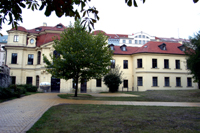
|
The
Portheimka villa is nicely located in Smichov, a borough
of Prague where many office buildings are under construction.
It is the location of Prague's Carrefour hypermarket
& many new department stores.
It is becoming a trendy area for artists. The villa
is located along a small park, that once was probably
part of the property. There are two buildings.
One on the left that we could visit, and one on the
right that is reserved for private events.
The villa is now under the responsibility
of an official preservation public office :
NARODNI DUM NA SMICHOVE
namesti 14, rijna 16
150 00 PRAHA
phone +420 2 570 999 27
Mrs Jaroslava MALIKOVA has the keys to the villa and
she very kindly gave us a complete tour.
The building is extremely well maintained.
It is used occasionally for concerts, and the second
floor was used as a studio by a local classical music
FM radio.
|
|
The
left aisle has three levels. There are two statues
in the front. They are copies of the originals which
are stored inside the building for preservation. On
the left site of the entrance, there is a curious
grotto decoration. |
|
On the ground floor, there is a
public cafe (Apostrof) and an area reserved for exhibitions
(empty when I visited). |
|
There
are several rooms on the first floor.
A central concert room with marble
on the walls and frescos painted on the ceiling.
(webmaster visiting ... ) |
|
Two
adjacent rooms with frescos on the walls and a few
paintings (none of which is a Portheim portrait). |
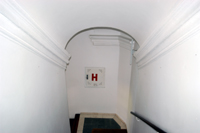
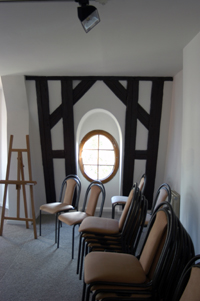 |
I
insisted on visiting the second floor which Mrs MALIKOVA
said was totally empty, and it was.
No Portheim portrait there either. |
|
At
the end of the park, there is a new office building
under construction and nearly completed. It is called
the Portheimka Center. On the picture, the P. villa
can be seen in the back on the right hand side of
the alley. |
|
Then
we went to the New Jewish Cemetery of Smichov.
It is a very small cemetery.
The two Portheim graves are in the back, on the right
hand side.
The monument on the left is the grave
of Joseph and Rosa von Portheim. At the bottom of
the plaque, there is a music score (Beethoven, opus
58 n. III).
This is the monument for which funds
are needed for renovation and maintenance.
Family
tree |
|
Left of the above monument is the grave of Mathilde
von Portheim geb. Philipp and Gustav von Portheim.
Family
tree
|
|
March 26, 2003
History of the Smichov Synagogue
Astrid Hofmanova
The Jewish ghetto of Prague evokes all sorts of magic and legends.
According to tradition, the first Jews arrived in Prague after the destruction of the temple in Jerusalem and they remained an important part of the cultural scene there from that time on.
Before its demolition, the ghetto was made up of dilapidated huts built on little, narrow, dark streets.
Among the remaining historical monuments that testify to the rich Jewish history associated with Prague, one can still find several synagogues in the Jewish neighborhood of Josefov : the oldest synagogue of Prague – the Old-New Synagogue, the Maisel synagogue, the High synagogue, the Klaus synagogue.
But there is another, less well-known synagogue situated outside the ghetto, in the Smichov neighborhood.
This synagogue is currently under reconstruction and, upon completion, is expected to house the archives of the Jewish communities of Bohemia and Moravia and some art treasures from the Jewish Museum of Prague.
Here, then, is the eventful history of the Smichov synagogue.
The synagogue was built in 1850 in the oldest neighborhood of Prague, Smichov.
At that time, the people in the Jewish community of Smichov worked in the textile factories that several rich, Jewish families - the Porges, Pribram and Dormitzer families - owned since the beginning of the 19th century.
The Porges brothers came from Oporto, Portugal together with a wave of Jewish refugees who fled Spain and Portugal in the 19th century.
[ note of the webmaster : this date is unlikely, provided ancestors of the Porges brothers are tracked back to 1600 in Prague. However, it makes sense to believe that their ancestors fled Portugal at the time of inquisition ca 1492/6 ]
The Jewish community was born in Smichov in the first half of the 18th century.
From 1794 on, it already had organized a social action group that helped the sick and needy, and founded a Jewish cemetery that was still being used until 1921.
In 1850, the Smichov Jewish community started to build its first synagogue but it was never finished for lack of funds.
Nevertheless, the Jewish community continued to grow and it was decided to build a new, very big synagogue in the neo-Roman style (exterior), with a Moorish interior.
At the end of the 19th century, the Jewish community of Smichov had 2000 members, with annual revenues of 5600 Florins.
It was comprised of eight foundations, including a “hevra kadisha” which assisted in burials and had 126 members, a bikur holim” of 80 members who visited the sick and the poor, and a sisterhood made up of 90 women.
In 1892, a Hebrew school was established and in 1903 the new Jewish cemetery “Na Malvazinkach” was founded.
The Porges von Portheim family, founders of one of the oldest textile factories in Smichov, are buried there.
In 1930-1931, the synagogue was renovated in the purist style based on Leopold Ehrmann ‘s architectural plans.
This renovation completely changed the appearance of the synagogue and transformed it into one of the rare, modern synagogues in Bohemia.
But, unfortunately, the following years proved disastrous for the Jews and their synagogue.
In autumn 1941, the synagogue was closed and its members were sent to concentration camps.
During the war, the synagogue became a warehouse for all the objects stolen from the Jews by the Nazis.
The Jewish community of Smichov was decimated during the war and ceased to exist after the war.
The synagogue, however, was once again used as a warehouse by the CKD company after the war, and, as a result, the interior of the synagogue was severely damaged.
So in 1986 it was decided to demolish the synagogue, but fortunately it never came about. Instead, the synagogue was restituted to the Jewish community in 1993 and its new owner, the Jewish Museum of Prague, decided to renovate it and rebuild.
Renovation of the synagogue started in 2002 and it is expected to be finished in two years in time to house the Jewish archives and various art objects mentioned earlier.
During the renovation process, some precious discoveries were made. In January 2003, for example, a time-capsule was found in the foundations of the synagogue, dated
August 30, 1863.
The parchment document was found in perfect condition, intact, and even wrapped in a piece of newspaper of the day.
This is unusual inasmuch as such documents were usually placed in a case.
The director of the Jewish Museum of Prague, M. Leo Pavlat, commented that this important document was divided into twelve sections, each one written in a different script and decorated in the same style, i.e. from classic empire writing with an accompanying fine linear design to neo-gothique writing and its naturalist embellishments.
The text of this document recounts the long history of the Jewish community of Smichov, going back to the 18th century, and relates their undying determination to build their own synagogue.
Interestingly, the document reveals that the actual construction of the synagogue was made possible thanks to the generosity of the mayor of Smichov, Frantisek Ringhofer, a non-Jew.
This year, the Synagogue of Smichov is celebrating its 140th anniversary.
The original parchment document described above is to be found in the Jewish Museum of Prague, whereas a facsimile has been placed in the spot where it was originally found, in the synagogue.
L'histoire de la synagogue de Smichov
[26-03-2003] Par Astrid Hofmanova
http://radio.cz/fr/article/39040
La magie et le fantastique de Prague trouvent un écho supplémentaire dans l'évocation légendaire de son ghetto juif.
Selon la tradition, les Juifs seraient arrivés dans la ville après la destruction du temple de Jérusalem et, quoi qu'il en soit, ce peuple reste une composante essentielle de l'amalgame culturel dont Prague est toujours pénétrée.
Une architecture labyrinthique aux ruelles étroites et sombres et aux baraques entassées, tel était le visage du Cinquième quartier, avant sa démolition...
Parmi les monuments historiques témoignant d'une riche histoire juive sur le territoire de Prague, il y a les synagogues situées notamment dans le quartier juif de Josefov : la plus vielle synagogue de Prague - la synagogue Vieille-Nouvelle, la synagogue Maisel, la synagogue Haute, la synagogue Klaus...
Celles-ci ont une consoeur moins connue, située hors des frontières de l'ancien ghetto, dans le quartier de Smichov. Cette synagogue est en reconstruction et depuis 2004, elle devrait abriter les archives des communautés juives de Bohême et de Moravie et un dépôt des collections d'art plastique du Musée juif de Prague.
Voici donc l'histoire mouvementée de la synagogue de Smichov.
La synagogue que je désire vous présenter a été construite dans la plus vieille banlieue de Prague, celle de Smichov, en 1850.
A l'époque, la communauté juive de Smichov devait son développement rapide à des usines textiles fondées depuis le début du XIXe siècle notamment par les riches familles juives, dont les Porges, les Pribram et les Dormitzer.
A titre d'exemple, les frères Porges sont venus de la ville d'Oporto au Portugal avec une vague de réfugiés juifs chassés d'Espagne et du Portugal au XIXe siècle.
La communauté juive est née à Smichov dans la première moitié du XVIIIe sècle et depuis 1794 elle a eu déjà une société de soutien aux malades et aux misérables et un cimetière où l'on enterrait jusqu'en 1921.
En 1850, la communauté juive de Smichov a construit sa première synagogue mais faute de moyens financiers, la construction de celle-ci n'a jamais été achevée.
Comme la communauté se développait très rapidement, on a décidé de construire une nouvelle synagogue, plus grande, dans le style néo-roman (extérieur) et mauresque (intérieur).
A la fin du XIXe siècle, la communauté juive de Smichov comptait déjà 2000 membres et ses revenus annuels étaient de 5600 florins.
Elle a créé huit fondations pour le temple, les veuves pauvres et les étudiants, sa confrérie funéraire comptait 126 membres, la société de soutien aux pauvres et aux malades 80 membres et une amicale féminine 90 membres.
En 1892, on a fondé à Smichov une école de Talmud-Tora.
Le nouveau cimetière juif Na Malvazinkach a été fondé en 1903.
Parmi les personnalités importantes, il y a le prosateur expressionniste Hermann Ungar ou le poête et traducteur Friedrich Adler qui y avaient trouvé le lieu du dernier repos.
Le cimetière abrite aussi des tombeaux de la famille Porges de Portheim, fondatrice de l'une des plus anciennes usines textiles de Smichov.
Dans les années 1930-1931, la synagogue de Smichov a subi une reconstruction d'envergure dans le style puriste, d'après les plans de l'architecte Léopold Ehrmann.
Cette reconstruction monumentale a complètement changé son visage extérieur et a transformé la synagogue en l'une des rares constructions synagogales modernes de Bohême.
Malheureusement, les années à venir ont réservé à cette synagogue un destin peu enviable.
En automne 1941, la synagogue est fermée et les membres de la communauté envoyés dans des camps de concentration nazis.
Pendant la guerre, elle abrite un dépôt des biens juifs confisqués.
Après la guerre, la communauté juive de Smichov ne reprends plus ses activités.
La synagogue sert de nouveau d'un dépôt, cette fois-ci celui de pièces de rechange de la firme CKD.
L'intérieur remanié à cette fin a considérablement dégradé cette construction.
En 1986, la synagogue est destinée àla démolition, mais celle-ci ne se réalise heureusement pas.
La synagogue n'est restituée à la communauté juive qu'en 1993, après quoi son propriétaire, le Musée juif de Prague, décide de la reconstruire.
Les travaux commencent en 2002 pour que, deux ans plus tard, elle puisse accueillir les archives et le dépôt des collections d'art plastique.
Lors de la reconstruction de la synagogue de Smichov, les bâtisseurs ont réalisé une découverte précieuse.
Le 23 janvier dernier, ils ont trouvé dans les fondations de la synagogue un document en parchemin rappelant l'achèvement de la construction de la synagogue, le 30 août 1863.
Le directeur du Musée juif de Prague, M. Leo Pavlat à propos de cette découverte.
Une curiosité accompagne cette découverte.
Le document a été découvert dans un état parfait, intact, bien qu'emballé seulement dans un papier journal de l'époque.
Normalement, les documents d'une telle importance sont mis dans un étui.
Ayant une forme et un contenu très intéressant, le document est divisé en douze champs dont chacun a une écriture et une décoration différente, depuis le style classique empire avec un fin dessin linéaire jusqu'à l'écriture néo-gothique et un ornement naturaliste.
Le texte du document rappelle la longue histoire de la communauté juive de Smichov remontant à la moitié du XVIIIème siècle ainsi que sa détermination, de longues années durant, de construire sa propre synagogue.
Le document a été réalisé par Joseph Bindeles, portraitiste et lithographe pragois réputé.
On peut lire aussi dans le texte que la construction a été achevée grâce à l'aide financière du maire de Smichov d'alors, industriel et député, Frantisek Ringhofer, qui n'était pas d'origine juive.
La synagogue de Smichov fête cette année le 140ème anniversaire de sa fondation.
Le document de fondation sera déposé au Musée juif de Prague et son fac-similé placé là où l'on a trouvé le document original.
----------------
Smichov Synagogue: symbol of forgotten era amid new commercial excess
[19-04-2003] By Rob Cameron
http://www.radio.cz/en/article/39803
On the left bank of the River Vltava, about a kilometre away from Prague Castle, is an area called Smichov.
It used to be a grimy, rather sordid neighbourhood, home to smoke-belching factories, the Staropramen brewery and the city's seediest bars.
Smichov has never had much to recommend it (or at least not in my opinion), except for one, rather curious landmark.
Just as the tram pulls out from the Andel station, you pass a grey, functionalist-looking building, its doors padlocked shut.
At first it looks wholly unremarkable, a storeroom or an electricity substation perhaps.
But if you peer closely at the walls, you spot an inscription written in Hebrew.
This is Smichov Synagogue.
It was built in 1863, originally in the neo-Romanesque and Moorish style, to serve Smichov's Jewish community.
Jews had lived in Smichov since the mid-18th century, and fought for many years to have a synagogue of their own.
It was later rebuilt by a functionalist architect, which explains its rather drab exterior.
Then, of course, came the war, and the synagogue was closed, although it was spared demolition by the Nazis.
After the war the Communists gave the building to the CKD heavy engineering works, which used it as a storeroom.
Not until 1989 was it returned to Prague's tiny Jewish community.
Since then the synagogue has remained padlocked and closed, but the area around it has received a thorough face lift.
Gone are the factories and the dilapidated buildings.
In their place have sprung up two enormous shopping centres, complete with multiplex cinema.
The Smichov Synagogue now finds itself sandwiched between these two commercial monoliths - a reminder of a different era.
The Jewish community has recently started renovating the synagogue, which will eventually serve as a depository for the Jewish Museum.
The Smichov Synagogue will probably not be open to the public, although private tours might be allowed.
The interior is said to be quite impressive, although for me, it's the location which is the most interesting thing about it.
What finer juxtaposition of Prague old and new : a forgotten place of worship and a reminder of the city's tragic past, amidst all this commercial excess.
June 2003
|

|





